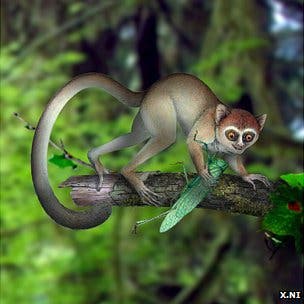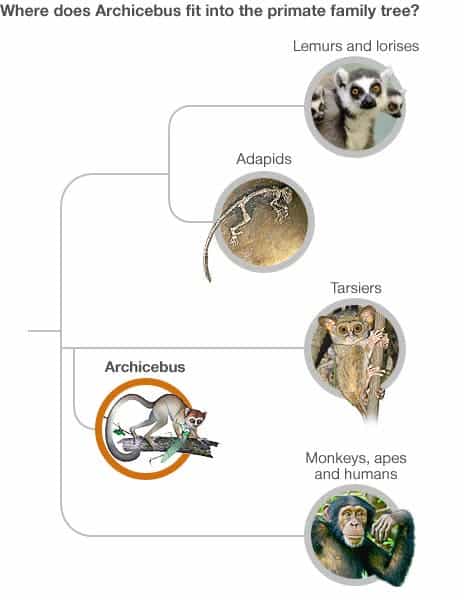At 55 million years old, it represents the earliest known member of this broad group of animals that includes humans. It may be no bigger than a mouse, but it is a primate, and a very valuable one at that; paleontologists have named it Archicebus, which roughly translates as “ancient monkey”.

The team which described this fossil puts it at the very base of the evolution tree of tarsiers – small primates which are now found exclusively in south-east Asia. But the emergence of Archicebus doesn’t only speak about its Asian followers – but about humans as well.
“We are all very curious about the ancestors of primates, including those of human beings,” said Dr Xijun Ni from the Chinese Academy of Sciences, Beijing, China. “From this almost complete skeleton, we can conclude that our ancestors were a kind of very small animal. It was very active and agile; and it lived in the trees and fed on insects,” he told BBC News.

The fossil was preserved on two slate slabs. Almost all of its bones are still observable, as well as some very nice impressions of its feet. Researchers used a European Synchrotron Radiation Facility (ESRF) – basically a fancy X-Ray machine.
“There’s no way you can prepare the fossil any better to see its features because you would end up with a powder; it’s extremely fragile,” explained the ESRF’s Dr Paul Tafforeau. “But when you scan it with synchrotron light, you can virtually extract the bones without touching them. This gives you access to the general anatomy and we can achieve very high resolution.”
So there you have it, our ancestors were small and agile primates, who emerged at a really key point in geologic history.
“At this time, 55 million years ago, the Earth was a jungle planet,” researchers added. “The whole Earth was covered with tropical jungle – full of trees for little scampery things to climb up and down on. It was an ideal time for primates to be evolving.”
Judging by its teeth and its overall small size, it probably ate insects. It also had big teeth which suggest good hunting vision, though the hunt probably took place during daytime, and less so during the night. But the most remarkable feature is its heel bone.
Far from resembling the shape of a tarsier, the bone looks just like what you’d expect from an arthropod.
“The heel, and the foot in general, was one of the most shocking parts of the anatomy of this fossil when we first saw it; because, frankly, the foot of this fossil primate looks like a small monkey, specifically like a marmoset.”, explains Dr Chris Beard from the Carnegie Museum of Natural History in Pittsburgh, US.
This emphasizes Archicebus’ proximity to the lineage split between humans and apes.
“What is means is that the common ancestor of tarsiers and anthropoids had some features that looked more like anthropoids than tarsiers. And I guess we shouldn’t be so surprised by this,” he told BBC News.







